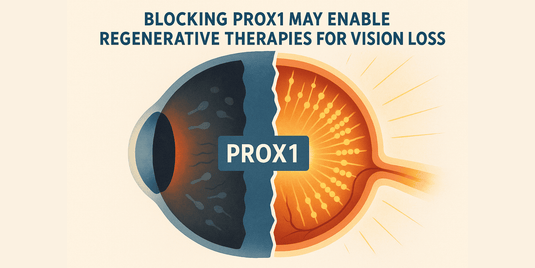For people living with retinal diseases like retinitis pigmentosa (RP) or glaucoma, one of the biggest challenges is that once retinal cells die, they don’t naturally grow back. In fish and amphibians, the eye can regenerate damaged cells thanks to special support cells called Müller glia. But in humans and other mammals, Müller glia don’t have the same repair powers.
A new study published in Nature Communications uncovers why—and points to a way forward.
The “Stop Sign” Blocking Eye Regeneration
The research team identified a protein called Prox1 that acts like a stop sign, blocking regeneration in the mammalian retina. In mice and humans with retinal degeneration, Müller glia accumulate Prox1. But in zebrafish—famous for their ability to repair their retinas—Müller glia stay free of Prox1.
Where does it come from? Surprisingly, the Müller glia don’t make Prox1 themselves. Instead, neighboring retinal neurons pass it over, almost like handing off an unwanted package.
What Happens If You Block Prox1?
When the scientists blocked Prox1 transfer in mice, something remarkable happened:
-
Müller glia were able to “reprogram” themselves into progenitor cells (cells that can grow into new retinal neurons).
-
These new cells could go on to replace damaged retinal neurons.
-
In mouse models of retinitis pigmentosa, this treatment slowed vision loss—and in some cases even generated new rod photoreceptors, the cells responsible for seeing in low light.
A Glimpse of Future Therapies
The team went a step further and used a virus to deliver an anti-Prox1 antibody directly into the eye. This treatment mopped up Prox1 before it could block regeneration. The results were hopeful: treated mice showed delayed vision loss and improved retinal health compared to untreated ones.
Why This Matters
For decades, scientists have wondered why mammals can’t regenerate their retinas like fish can. This study suggests that one major reason is Prox1 acting as a barrier. By removing that barrier, researchers may have uncovered a path toward therapies that could one day restore vision in humans with degenerative retinal diseases.
The Road Ahead
While this is a big step forward, it’s still early days. The experiments were done in mice, and long-term safety and effectiveness in humans remain to be proven. But the discovery of Prox1’s role gives researchers a powerful new target.
In short: if we can learn how to silence the eye’s stop signs, we might finally help it start repairing itself.
Sources:



